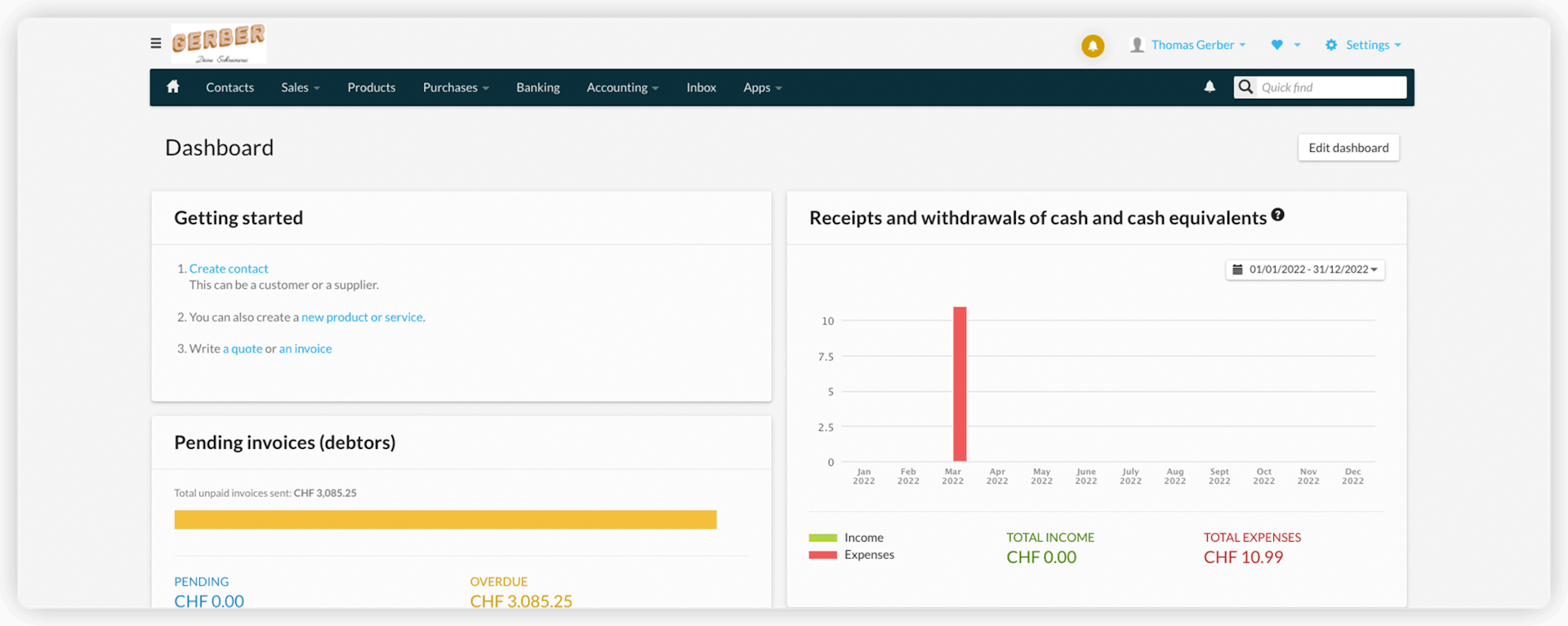When you acquire a new asset in your company, such as a machine or a vehicle, it will lose value over the years of its use. Depreciation enables this annual loss of value to be reflected and made clear in your accounts. We will explain what depreciation is, answer questions about the different depreciation methods, and explain how to post depreciation, and more!

What is depreciation?
In accounting, depreciation is the recording and offsetting of impairments (losses in value). Many fixed assets are subject to constant (scheduled) impairment. However, current assets can also undergo (usually unscheduled) impairment. These impairments are recorded as depreciation. This reduces a company's reported profit, meaning it will consequently pay less profit tax.
Depreciation explained with a simple example
A company acquires a new asset, for example, a machine worth CHF 30,000. This machine is a tangible asset that is intended to remain in the company for the long term. Tangible assets are part of the fixed assets and can be found on the assets side of the balance sheet.
The machine will be used in the company over the next three years, and will therefore decline in value. Now the question arises: How can this impairment/loss in value be correctly recorded in accounting? It is precisely this process of offsetting and recording this impairment over something's expected useful life that is called depreciation in accounting.
To that end, the acquisition or production costs of the tangible asset are distributed evenly (linearly) or in decreasing amounts (degressively) over the financial years. In the closing balance sheet and income statement, our example would look something like this:
| BALANCE SHEET | INCOME STATEMENT | ||||
|---|---|---|---|---|---|
| Liquid assets | Tangible assets | Equity | Income | Expenses | |
| Purchases | ~30,000 | +30,000 | |||
| from year 1 | -10,000 | -10,000 | +10,000 | ||
| from year 2 | -10,000 | -10,000 | +10,000 | ||
| from year 3 | -10,000 | -10,000 | +10,000 | ||
What types of impairments are depreciated?
Various losses in value can be depreciated. These include, among others, degradation and wear and tear over time, wear and tear through use, loss of value due to weather conditions, obsolescence as a result of technical progress, changes in demand, and expiry of property rights or rights of use.
A distinction must be made between scheduled and unscheduled impairment:
Scheduled impairment
In the case of depreciable fixed assets, the impairment is usually foreseeable or scheduled. Examples are: wear and tear due to use, or impairment due to weather conditions.
In that case, the depreciation is scheduled: a depreciation schedule is prepared for recording the production or acquisition costs, the expected useful life, and the depreciation method.

Unscheduled impairment
An unscheduled impairment is an impairment due to natural disasters, hidden defects, accidents, or other unforeseeable issues.
Unscheduled impairments are not included in the depreciation schedule. An unscheduled depreciation is required in such circumstances. The new, reduced value of the item will now serve as the basis for calculating the new depreciation amounts in the depreciation schedule.

What kind of depreciation methods are there?
There are two ways to record depreciation in accounting:
Linear depreciation
With linear depreciation, the same amount is depreciated for an asset every year. That means the acquisition or production costs of the asset can simply be distributed evenly over the financial years in which it is expected to be used.
Example: A machine is purchased for CHF 30,000 and is expected to be used for 5 years. In this case, the depreciation schedule would be as follows:
| Year | Depreciation amount | Residual book value |
|---|---|---|
| 1 | CHF 6,000 | (CHF 30,000 - CHF 6,000) = 24,000 |
| 2 | CHF 6,000 | (CHF 24,000 - CHF 6,000) = 18,000 |
| 3 | CHF 6,000 | CHF 12,000 |
| 4 | CHF 6,000 | CHF 6,000 |
| 5 | CHF 6,000 | CHF 0 |
You will depreciate CHF 6,000 every year: in the first year, CHF 6,000 of the purchase price (CHF 30,000) will be depreciated. From the second year onwards, CHF 6,000 of the respective residual book value of the previous year will be depreciated.
Degressive depreciation
In the case of degressive depreciation, the annual depreciation amounts are not a consistent amount, unlike in the linear depreciation method. The depreciation amounts decrease every year.
Example: A machine is purchased for CHF 30,000 and is expected to be used for 5 years. The depreciation should be at the legally prescribed depreciation rate of 40% for this fixed asset. In this case, the depreciation schedule would be as follows:
| Year | Depreciation amount | Residual book value |
|---|---|---|
| 1 | (CHF 30,000 * 0.4) = CHF 12,000 | (CHF 30,000 - CHF 12,000) = CHF 18,000 |
| 2 | (CHF 18,000 * 0.4) = CHF 7,200 | (CHF 18,000 - CHF 7,200) = CHF 10,800 |
| 3 | CHF 4,320 | CHF 6,480 |
| 4 | CHF 2,592 | CHF 3,888 |
| 5 | CHF 1,555.20 | CHF 2,332.80 |
| 6 | CHF 2,332.80 | CHF 0 |
In the first year, multiply the acquisition cost by the degression factor to get the depreciation amount. From the second year onwards, multiply the residual book value by the degression factor to obtain the respective depreciation amount. In the final year, the entire residual book value of the previous year is depreciated.
Posting depreciation
There are two ways of accounting for depreciation: direct and indirect accounting.
Direct depreciation
With direct depreciation, you deduct the depreciation from the value of the asset (tangible fixed assets - impairment = depreciation). You debit the depreciation amount from the respective asset account.
Example posting record: Depreciation on machinery account to the machinery account.
Indirect depreciation
You depreciate the asset indirectly using a value adjustment. You indicate this on the liabilities side of the balance sheet.
Example posting record: Depreciation of assets to the value adjustment of assets.
The start and end of depreciation
When the depreciation is undertaken is also important.
Start of depreciation
Depreciation starts on the date of purchase or delivery – not on the date of use. Additionally, this calculation is accurate to the month.
Example: A company buys a new machine for CHF 30,000 on 10 April, which is to be used for 5 years. Now the company must depreciate the entire month of April along with the remaining months of the first calendar or business year (in other words, a total of 9 months): the depreciation amounts to CHF 4,500 pro rata temporis in the first year.
End of deprecation
You depreciate until you are no longer using the item in question, for example, you sell it, it breaks down, or you scrap it. If, for example, a machine is completely depreciated after 5 years, you may of course continue to use it. In that case, you will continue to depreciate a so-called memo value of CHF 1 in the books.
Easily automate depreciation in bexio
Use the bexio accounting software together with the Accrio integration feature to easily automate your depreciation: enter the machine once, calculate the depreciation at the end of the year with two clicks, and transfer it to the accounting software.

Frequently asked questions about depreciation
Both. Depreciation is an expense because a business "loses" money when an asset loses value. Depreciation is a cost because this loss in value is part of the cost incurred when fixed assets are used for delivering operational services. Depreciation reduces profit in the income statement. In cost accounting, depreciation is a fixed cost of service provision.
Yes. Depreciation represents the loss in value of fixed assets over its useful life. In the profit and loss account, depreciation is recognised as an expense – it is deducted from turnover or income, thereby reducing profit.
The Swiss Code of Obligations (OR), Art. 960a, provides the legal framework in this respect. You can depreciate using the linear or degressive method. With linear depreciation, you divide the acquisition value by its useful life to get the annual depreciation amount. With the degressive method, you deduct a percentage of the current book value as depreciation. The chosen depreciation methodology must be consistent and understandable.
The Swiss Code of Obligations (OR) does not provide a catalogue specifying useful lives for specific fixed assets. You can determine these based on empirical values, manufacturer specifications, or industry standards. When in doubt, a company should choose a conservatively estimated shorter useful life, in order to act in accordance with the principle of prudence.
Test out bexio now for 30 days free of charge and with no obligation
Test all the features of bexio, the simple business software for your SME administration.




